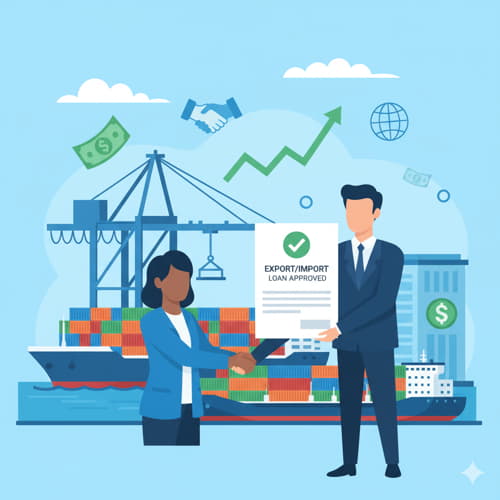Best Export Import Loans 2025: Boost Global Trade Financing
Best Export Import Loans 2025: Boost Global Trade Financing – A Strategic Guide for Global Trade in 2026
Introduction: Fueling Cross-Border Commerce: 2025 & Planning for 2026
Global trade is the lifeblood of modern economies. Businesses that import and export goods face unique financial challenges. They need capital to manage long cash conversion cycles. They must mitigate high risks associated with international transactions. Export Import Loans (also known as Trade Finance) are specialized tools. They provide the necessary capital and guarantees to facilitate cross-border commerce. They bridge the gap between paying suppliers and receiving payment from overseas buyers.
In 2025, geopolitical volatility and supply chain shifts make robust trade financing essential. US exporters need reliable funding to fulfill large orders. Importers require secure payment methods. Looking ahead to 2026, trade experts predict increasing reliance on government-backed programs. This guide defines Export Import Loans. It details the best financing options available for US businesses in 2025. It outlines the crucial role of government agencies like EXIM Bank. It,s provides a strategic roadmap for securing reliable global trade financing through 2026.
## Trade Finance Defined: Mitigating International Risk
Trade finance is crucial. It mitigates two primary risks inherent in global transactions: Buyer Risk (non-payment) and Supplier Risk (non-delivery).
The Core Problem: Long Cycles
A US exporter might fulfill an order. They ship the goods. They wait 60 to 90 days for the overseas buyer to pay. This creates a significant gap in the exporter’s working capital. Trade finance fills this gap.
Key Trade Finance Tools:
- Working Capital: Funds for purchasing raw materials and manufacturing the goods.
- Risk Mitigation: Insurance or guarantees protecting against default or political risk.
- Payment Mechanism: Secure methods like Letters of Credit (LCs) ensure payment.
## Best Export Import Funding Options in 2025
US businesses should prioritize solutions that minimize risk while providing necessary liquidity.
1. Export-Import Bank of the United States (EXIM Bank) Programs
The EXIM Bank is the official export credit agency of the US. It does not compete with private lenders. It takes on risks private institutions cannot.
- Working Capital Loan Guarantee: EXIM guarantees loans issued by commercial banks. This encourages banks to lend capital to US exporters. Borrowers use the funds for inventory, raw materials, or fulfilling large contracts. This is often the best option for small- and medium-sized exporters.
- Export Credit Insurance: This insurance protects the exporter against the risk of the foreign buyer defaulting on payment. This allows exporters to offer competitive, open-account credit terms.
2. Letters of Credit (LCs)
LCs are arguably the most essential tool in import-export finance. An LC is a promise from the buyer’s bank. The bank guarantees payment to the seller once the seller provides proof (shipping documents) that the goods shipped.
- Benefit for Exporter: The exporter minimizes buyer risk. They receive payment assurance from a reliable bank.
- Benefit for Importer: The importer ensures the bank will only pay the exporter once the specified goods are shipped.
3. Purchase Order (PO) Financing
This option is ideal for small businesses with large, confirmed purchase orders but lacking the cash to fulfill them.
- How it Works: The lender advances funds directly to the supplier to cover the manufacturing costs. Once the buyer pays the US business, the lender takes the initial advance plus fees.
- Requirement: The lender must see a confirmed, non-cancellable purchase order from a creditworthy end-buyer.
4. Factoring (Accounts Receivable Financing)
Exporters often use Factoring. The exporter sells their international invoices (accounts receivable) to a factoring company (Factor) at a discount.
- Benefit: The exporter receives immediate cash (usually 70%-90% of the invoice value). This solves the long cash conversion cycle problem. The Factor takes over the responsibility of collecting payment from the overseas buyer.
- Risk: The effective cost (discount rate) is often higher than a traditional loan.
## Key Requirements for 2025 Global Trade Financing
Securing trade finance requires demonstrating transaction security and operational capability.
1. Foreign Buyer Creditworthiness
Lenders and insurers (including EXIM) rigorously evaluate the credit risk of the foreign buyer. They require detailed financial information on the overseas company. The transaction’s viability hinges on the buyer’s payment ability.
2. Collateral and Security
For working capital loans, lenders require collateral. This collateral includes the goods being exported (the inventory), the raw materials, and sometimes the receivables generated from the sale.
3. Clear Documentation (The Most Critical Element)
International trade relies entirely on documents. Lenders demand impeccable documents. These include:
- Signed Purchase Orders or Sales Contracts.
- Bills of Lading (proof of shipment).
- Certificate of Origin.
- Compliance with UCP 600 (Uniform Customs and Practice for Documentary Credits) rules for LCs. Errors in documentation halt payment.
4. Compliance and Licensing
The business must comply fully with all US export controls and sanctions. Lenders check for proper export licenses and adherence to regulations from agencies like the Office of Foreign Assets Control (OFAC).
## Strategy for 2026: Preparing for Global Expansion
Global supply chains will continue to shift in 2026. US businesses must be strategically prepared to finance international growth.
1. Build a Relationship with an EXIM-Approved Lender
- 2025 Action: Identify local or regional banks that actively participate in EXIM Bank’s Working Capital Guarantee Program.
- 2026 Benefit: This relationship simplifies the application process. It provides access to government-backed financing that conventional banks often avoid.
2. Diversify Foreign Buyer Payment Terms
- 2025 Action: Do not rely solely on open account (buy now, pay later) terms. Negotiate a mixture of payment terms: LCs for new buyers, open account for trusted partners.
- 2026 Benefit: Payment term diversification manages risk. It provides a more stable cash flow forecast.
3. Invest in Compliance Training
- 2025 Action: Train staff responsible for documentation (shipping, finance) thoroughly on international banking rules and regulatory compliance.
- 2026 Benefit: Reducing documentation errors accelerates payment collection. It avoids costly delays and penalties.
4. Secure Political Risk Insurance
- 2025 Action: For transactions involving unstable regions, purchase political risk insurance. This protects against losses from war, expropriation, or currency non-convertibility.
- 2026 Benefit: This insurance opens up new, high-growth but high-risk markets that competitors may avoid.
## Final Word: Mastering the Global Transaction
Securing the Best Export Import Loans in 2025 demands specific knowledge and strategic partnerships. Therefore, US businesses must leverage the resources of the EXIM Bank. They must prioritize secure payment tools like Letters of Credit. They must maintain flawless documentation. By mastering the complexities of trade finance and mitigating international risk, businesses ensure robust working capital. They successfully boost their global trade volume throughout 2026 and solidify their position in the world market.



